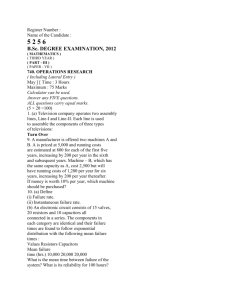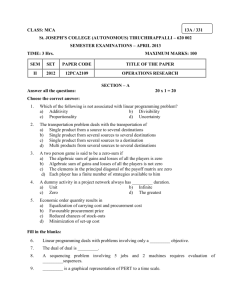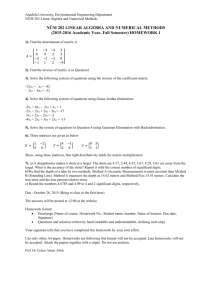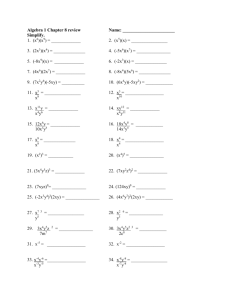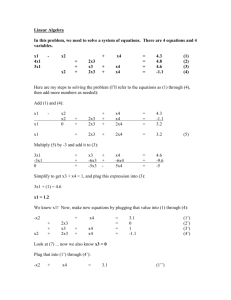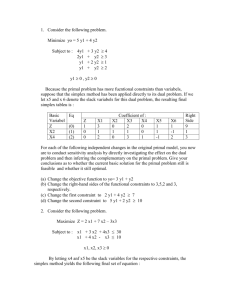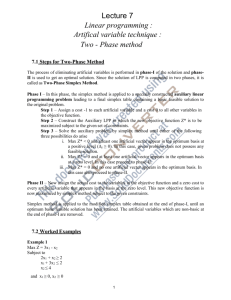slides
advertisement
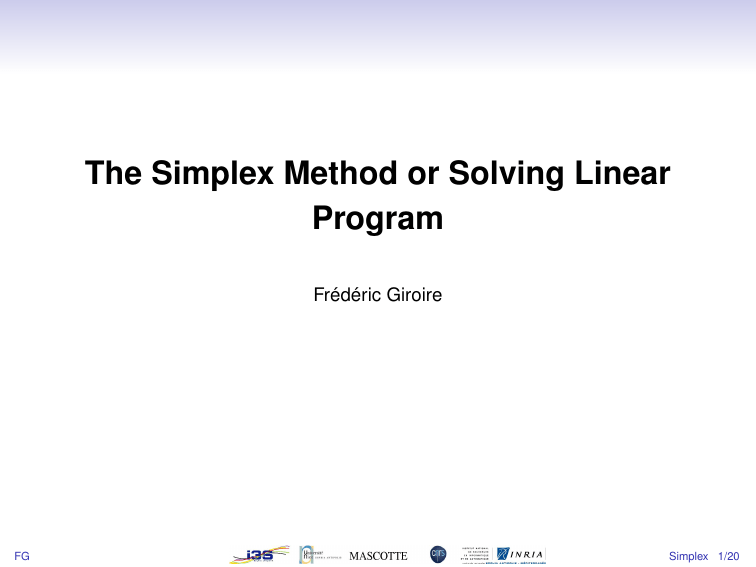
The Simplex Method or Solving Linear Program Frédéric Giroire FG Simplex 1/20 Motivation • Most popular method to solve linear programs. • Principle: smartly explore basic solutions (corner point solutions), improving the value of the solution. FG Simplex 2/20 The simplex Start with a problem written under the standard form. Maximize 5x1 Subject to : 2x1 4x1 3x1 FG + 4x2 + 3x3 + 3x2 − x3 ≤ 5 + x2 − 2x3 ≤ 11 + 4x2 − 2x3 ≤ 8 x1 , x2 , x3 ≥ 0. Simplex 3/20 The simplex First step: introduce new variables, slack variables. 2x1 + 3x2 + x3 ≤ 5 We note x4 the slack (difference) between the right member and 5, that is x4 = 5 − 2x1 − 3x2 − x3 . The inequation can now be written as x4 ≥ 0. FG Simplex 4/20 The simplex Similarly, for the 2 others inequalities: 4x1 3x1 + x2 − 2x3 ≤ 11 + 4x2 − 2x3 ≤ 8 We define x5 and x6 : x5 x6 = 11 − 4x1 − x2 − 2x3 = 8 − 3x1 − 4x2 − 2x3 And the inequalities can be written as x5 ≥ 0, x6 ≥ 0. FG Simplex 5/20 The simplex To summarize, we introduce three slack variables x4 , x5 , x6 : x4 x5 x6 z = 5 − 2x1 = 11 − 4x1 = 8 − 3x1 = 5x1 − 3x2 − x2 − 4x2 + 4x2 − x3 − 2x3 − 2x3 + 3x3 . The problem can be written as: Maximize z subject to x1 , x2 , x3 , x4 , x5 , x6 ≥ 0. slack variables x4 , x5 , x6 decision variables x1 , x2 , x3 . The two problems are equivalent. FG Simplex 6/20 The simplex Second step: Find an initial solution. In our example, x1 = 0, x2 = 0, x3 = 0 is feasible. We compute the value of x4 , x5 , x6 . x4 = 5 − 2x1 − 3x2 − x3 = 5 Similarly, x5 = 11 and x6 = 8. We get an initial solution x1 = 0, x2 = 0, x3 = 0, x4 = 5, x5 = 11, x6 = 8 of value z = 0 FG Simplex 7/20 The simplex Dictionary: x4 x5 x6 z = 5 − 2x1 = 11 − 4x1 = 8 − 3x1 = 5x1 − 3x2 − x2 − 4x2 + 4x2 − x3 − 2x3 − 2x3 + 3x3 . Basic variables: x4 , x5 , x6 , variables on the left. Non-basic variable: x1 , x2 , x3 , variables on the right. A dictionary is feasible if a feasible solution is obtained by setting all non-basic variables to 0. FG Simplex 8/20 The simplex Dictionary: x4 x5 x6 z = 5 − 2x1 = 11 − 4x1 = 8 − 3x1 = 5x1 − 3x2 − x2 − 4x2 + 4x2 − x3 − 2x3 − 2x3 + 3x3 . Basic variables: x4 , x5 , x6 , variables on the left. Non-basic variable: x1 , x2 , x3 , variables on the right. A dictionary is feasible if a feasible solution is obtained by setting all non-basic variables to 0. FG Simplex 8/20 The simplex Simplex strategy: find an optimal solution by successive improvements. Rule: we increase the value of the variable of largest positive coefficient in z. x4 x5 x6 z = 5 − = 11 − = 8 − = 2x1 4x1 3x1 5 x1 − 3x2 − x2 − 4x2 + 4x2 − x3 − 2x3 − 2x3 + 3x3 . Here, we try to increase x1 . FG Simplex 9/20 The simplex How much can we increase x1 ? x4 x5 x6 z = 5 − 2x1 = 11 − 4x1 = 8 − 3x1 = 5x1 − 3x2 − x2 − 4x2 + 4x2 − x3 − 2x3 − 2x3 + 3x3 . We have x4 ≥ 0 . It implies 5 − 2x1 ≥ 0, FG that is x1 ≤ 5 2 . Simplex 10/20 The simplex How much can we increase x1 ? x4 x5 x6 z = 5 − 2x1 = 11 − 4x1 = 8 − 3x1 = 5x1 − 3x2 − x2 − 4x2 + 4x2 − x3 − 2x3 − 2x3 + 3x3 . We have x4 ≥ 0 . It implies 5 − 2x1 ≥ 0, that is x1 ≤ 5/2 . Similarly, x5 ≥ 0 gives x1 ≤ 11/4. x6 ≥ 0 gives x1 ≤ 8/3. FG Simplex 11/20 The simplex How much can we increase x1 ? x4 x5 x6 z = 5 − 2x1 = 11 − 4x1 = 8 − 3x1 = 5x1 − 3x2 − x2 − 4x2 + 4x2 − x3 − 2x3 − 2x3 + 3x3 . We have x4 ≥ 0 . It implies 5 − 2x1 ≥ 0, that is x1 ≤ 5/2 Strongest constraint Similarly, x5 ≥ 0 gives x1 ≤ 11/4. x6 ≥ 0 gives x1 ≤ 8/3. FG Simplex 12/20 The simplex How much can we increase x1 ? x4 x5 x6 z = 5 − 2x1 = 11 − 4x1 = 8 − 3x1 = 5x1 − 3x2 − x2 − 4x2 + 4x2 − x3 − 2x3 − 2x3 + 3x3 . We have x4 ≥ 0 . It implies 5 − 2x1 ≥ 0, that is x1 ≤ 5/2 Strongest constraint We get a new solution: x1 = 5/2, x4 = 0 with better value z = 5 · 5/2 = 25/2. We still have x2 = x3 = 0 and now x5 = 11 − 4 · 5/2 = 1, x6 = 8 − 3 · 5/2 = 1/2 FG Simplex 13/20 The simplex We build a new feasible dictionary. x4 x5 x6 z = 5 − 2x1 = 11 − 4x1 = 8 − 3x1 = 5x1 − 3x2 − x2 − 4x2 + 4x2 − x3 − 2x3 − 2x3 + 3x3 . x1 enters the bases and x4 leaves it: x1 FG = 5/2 − 3/2x2 − 1/2x3 − 1/2x4 Simplex 14/20 The simplex We replace x1 by its expression in function of x2 , x3 , x4 . x1 x5 x6 z FG = 5/2 − 1/2x4 − 3/2x2 = 11 − 4(5/2 − 3/2x2 − 1/2x3 − 1/2x4 ) − x2 = 8 − 3(5/2 − 3/2x2 − 1/2x3 − 1/2x4 ) − 4x2 = 5(5/2 − 3/2x2 − 1/2x3 − 1/2x4 ) + 4x2 − 1/2x3 − 2x3 − 2x3 + 3x3 . Simplex 15/20 The simplex Finally, we get the new dictionary: x1 x5 x6 z FG = = = = 5 2 − 32 x2 − 1 + 5 x2 1 + 12 x2 − 2 25 − 72 x2 + 2 1 2 x3 1 2 1 2 x3 x3 − 12 x4 + 2 x4 + 32 x4 − 52 x4 . Simplex 16/20 The simplex Finally, we get the new dictionary: x1 = 5/ 2 − 3 2 x2 x5 1 x2 1/ 2 + + 5 x6 = = z = 25/2 1 2 x2 − 1 2 − 1 2 x3 − 1 2 x4 2 x4 x3 + + 3 2 x4 − 7/2 x2 + 1/2 x3 − 5/2 x4 . We can read the solution directly from the dictionary: Non basic variables: x2 = x3 = x4 = 0. Basic variables: x1 = 5/2, x5 = 1, x6 = 1/2. Value of the solution: z = 25/2. FG Simplex 17/20 The simplex x1 x5 x6 z = = = = − 32 x2 − 1 + 5 x2 1 + 12 x2 − 2 25 − 72 x2 + 2 5 2 1 2 x3 1 2 1 2 x3 x3 − 12 x4 + 2 x4 + 32 x4 − 52 x4 . New step of the simplex: - x3 enters the basis (variable with largest positive coefficient). - 3d equation is the strictest constaint x3 ≤ 1. - x6 leaves the basis. FG Simplex 18/20 The simplex New feasible dictionary: x3 x1 x5 z = 1 = 2 = 1 = 13 + x2 − 2x2 + 5x2 − 3x2 + 3x4 − 2x6 − 2x4 + x6 + 2x4 − x4 − x6 . With new solution: x1 = 2, x2 = 0, x3 = 1, x4 = 0, x5 = 1, x6 = 0 of value z = 13. This solution is optimal. All coefficients in z are negative and x2 ≥ 0, x4 ≥ 0, x6 ≥ 0, so z ≤ 13. FG Simplex 19/20 The simplex New feasible dictionary: x3 x1 x5 z = 1 = 2 = 1 = 13 + x2 − 2x2 + 5x2 − 3x2 + 3x4 − 2x6 − 2x4 + x6 + 2x4 − x4 − x6 . With new solution: x1 = 2, x2 = 0, x3 = 1, x4 = 0, x5 = 1, x6 = 0 of value z = 13. This solution is optimal. All coefficients in z are negative and x2 ≥ 0, x4 ≥ 0, x6 ≥ 0, so z ≤ 13. FG Simplex 19/20 Take Aways • Most popular method to solve linear programs. • Principle: smartly explore basic solutions (corner point solutions), improving the value of the solution. • Complexity: • In theory, NP-complete (can explore a number of solutions exponentiel in the number of variables and constraints). • In practice, almost linear in the number of constraints. • Polynomial methods exists: the ellipsoid method. FG Simplex 20/20
